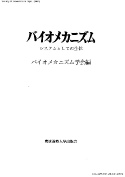Volume 22
Displaying 1-24 of 24 articles from this issue
- |<
- <
- 1
- >
- >|
-
2014Volume 22 Pages i-ii
Published: 2014
Released on J-STAGE: February 15, 2017
Download PDF (194K) -
2014Volume 22 Pages 1-12
Published: 2014
Released on J-STAGE: February 15, 2017
Download PDF (1652K)
-
2014Volume 22 Pages 15-26
Published: 2014
Released on J-STAGE: February 15, 2017
Download PDF (1826K) -
2014Volume 22 Pages 27-36
Published: 2014
Released on J-STAGE: February 15, 2017
Download PDF (1016K) -
2014Volume 22 Pages 37-47
Published: 2014
Released on J-STAGE: February 15, 2017
Download PDF (1265K) -
2014Volume 22 Pages 49-58
Published: 2014
Released on J-STAGE: February 15, 2017
Download PDF (1400K) -
2014Volume 22 Pages 59-68
Published: 2014
Released on J-STAGE: February 15, 2017
Download PDF (1031K) -
2014Volume 22 Pages 69-78
Published: 2014
Released on J-STAGE: February 15, 2017
Download PDF (876K)
-
2014Volume 22 Pages 81-91
Published: 2014
Released on J-STAGE: February 15, 2017
Download PDF (1262K) -
2014Volume 22 Pages 93-103
Published: 2014
Released on J-STAGE: February 15, 2017
Download PDF (883K) -
2014Volume 22 Pages 105-117
Published: 2014
Released on J-STAGE: February 15, 2017
Download PDF (1361K) -
2014Volume 22 Pages 119-128
Published: 2014
Released on J-STAGE: February 15, 2017
Download PDF (1132K) -
2014Volume 22 Pages 129-139
Published: 2014
Released on J-STAGE: February 15, 2017
Download PDF (1012K)
-
2014Volume 22 Pages 143-154
Published: 2014
Released on J-STAGE: February 15, 2017
Download PDF (2162K) -
2014Volume 22 Pages 155-166
Published: 2014
Released on J-STAGE: February 15, 2017
Download PDF (1974K) -
2014Volume 22 Pages 167-176
Published: 2014
Released on J-STAGE: February 15, 2017
Download PDF (845K) -
2014Volume 22 Pages 177-187
Published: 2014
Released on J-STAGE: February 15, 2017
Download PDF (1095K) -
2014Volume 22 Pages 189-199
Published: 2014
Released on J-STAGE: February 15, 2017
Download PDF (1349K)
-
2014Volume 22 Pages 203-211
Published: 2014
Released on J-STAGE: February 15, 2017
Download PDF (1483K) -
2014Volume 22 Pages 213-224
Published: 2014
Released on J-STAGE: February 15, 2017
Download PDF (1333K) -
2014Volume 22 Pages 225-236
Published: 2014
Released on J-STAGE: February 15, 2017
Download PDF (2211K) -
2014Volume 22 Pages 237-248
Published: 2014
Released on J-STAGE: February 15, 2017
Download PDF (1435K) -
2014Volume 22 Pages 249-258
Published: 2014
Released on J-STAGE: February 15, 2017
Download PDF (1029K) -
2014Volume 22 Pages 259-267
Published: 2014
Released on J-STAGE: February 15, 2017
Download PDF (2570K)
- |<
- <
- 1
- >
- >|
